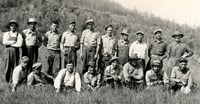On their many voyages to the Hawaiian Islands, Captain James Cook and his crew became familiar with the aikane, a select group of men who had sexual relations with the king and other ali'i, or royals. Several journal entries from their extended stays at Kealakekua Bay describe the openness of these relationships.
- Fort Scott National Historic Site
The Osage
- Locations: Fort Scott National Historic Site

Before the arrival of Europeans, the Osage Indians roamed a vast domain in the heart of North America. Although the Osage were a proud and powerful tribe, they could not withstand the pressure of European civilization. Soon after French fur trappers established contact with the Osages in the 1670s, their way of life began to change.
- Fort Scott National Historic Site
Permanent Indian Frontier
- Locations: Fort Scott National Historic Site
- Fort Scott National Historic Site
Forgotten Warriors: American Indian Home Guard
- Locations: Fort Scott National Historic Site

There's no place like home! To Native Americans suffering in barren refugee camps in eastern Kansas during the Civil War, thoughts of home must have crossed their minds as they longed for the warmth and security of a home in Indian Territory (Oklahoma). While some could remember when home was elsewhere, after more than two decades, many had come to regard Indian Territory as home.

This guide is intended to help teachers engage students on topics connected to the 250th anniversary of the Declaration of Independence. This commemoration goes beyond studying the document itself. The Declaration outlined values and promises for what kind of country the United States could be. Find lesson plans and other resources to help you talk about themes related to the American Revolution.
- Fort Stanwix National Monument
The Battle of Oriskany: "Blood Shed a Stream Running Down" (Teaching with Historic Places)
- Locations: Fort Stanwix National Monument

By the time of the Revolutionary War, Dutch, German, Irish, Scotch, and British settlers prospered from lucrative trade and productive farms. Yet the whole area suffered from long-established prejudices and hatred between groups and individuals. When war broke out, European Americans and American Indians fought each other for control of New York's political power, land, and commerce. No episode better captures the brutal civil war than the Battle of Oriskany.
- Grand Portage National Monument
Stewardship at Grand Portage National Monument
- Locations: Grand Portage National Monument

The National Park Service and the Grand Portage Band of the Lake Superior Chippewa work together at Grand Portage National Monument to support, interpret, and preserve the lifeways of the Ojibwe people, including the historic values of the Grand Portage trail. The Band has long been involved in stewardship of the Monument, where tribe members play a critical role in management, landscape maintenance, and historic preservation.
- Wrangell - St Elias National Park & Preserve
Bone and Copper Arrows Found in Melting Ice Patches
- Locations: Wrangell - St Elias National Park & Preserve

Read the abstract and get the link to an article published in the Journal of Glacial Archaeology on new artifacts found in ice patches in the St Elias Mountains: Thomas, C. D., P. G. Hare, J. D. Reuther, J. S. Rogers, H. K. Cooper, and E. J. Dixon. 2020. Yukon First Nation use of copper for end-blades on hunting arrows. Journal of Glacial Archaeology (2016):109-131.
- Locations: Captain John Smith Chesapeake National Historic Trail, George Washington Memorial Parkway, Manassas National Battlefield Park, Prince William Forest Park, Star-Spangled Banner National Historic Trail, Wolf Trap National Park for the Performing Arts

The Racial Integrity Act of 1924 banned interracial marriage in Virginia. It also required Virginians to register their race as either "white" or "colored." One of the many consequences of this discriminatory policy was the erasure of the Indigenous identity from public records. To this day, Indigenous people in Virginia have difficulty tracing their lineage due to this century-old policy.
- Locations: Captain John Smith Chesapeake National Historic Trail, Chesapeake Bay, Star-Spangled Banner National Historic Trail

This timeline provides an overview of major historical events affecting the Chesapeake's Indigenous peoples since the time of European arrival. Beginning with the first interactions with Spanish explorers in the late 1500s and concluding in the present day, this timeline describes some of the major impacts of colonization on the Chesapeake's Indigenous communities.
Last updated: September 14, 2023


